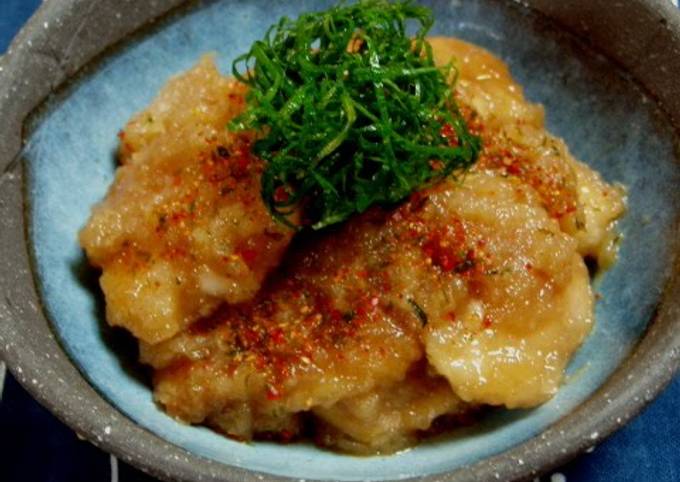Japanese-Style Sautéed Chicken Breast Mizore Stew. Chicken Is Healthy, Versatile And Tasty, As Well As Being Popular With Kids. It's Easy To Understand Why Chicken Is A Family Favourite In Australia. Great recipe for Japanese-Style Sautéed Chicken Breast Mizore Stew.
 If the chicken changes color too quickly, then the oil temperature is too high.
Either put a few more pieces of chicken in the oil or lower the heat.
Looking for Asian-style chicken breast recipes?
You can have Japanese-Style Sautéed Chicken Breast Mizore Stew using 10 ingredients and 8 steps. Here is how you achieve it.
If the chicken changes color too quickly, then the oil temperature is too high.
Either put a few more pieces of chicken in the oil or lower the heat.
Looking for Asian-style chicken breast recipes?
You can have Japanese-Style Sautéed Chicken Breast Mizore Stew using 10 ingredients and 8 steps. Here is how you achieve it.
Ingredients of Japanese-Style Sautéed Chicken Breast Mizore Stew
- It's of Chicken breast.
- Prepare of ●Salt and pepper.
- It's of ●Juice from grated ginger.
- Prepare of Katakuriko.
- Prepare of Vegetable oil.
- Prepare of ◎Dashi stock.
- You need of each ◎Soy sauce and sugar.
- It's of ◎Sake.
- It's of cm owrth Daikon radish.
- It's of as much (to taste) of one Ichimi spice or Sansho pepper.
Chicken Nanban is deep-fried chicken with tartar sauce, a dish from Miyazaki prefecture in Kyusyu, the southern big island of Japan. Want to cook whole chicken quicker and more evenly? Remove the backbone with a knife or kitchen scissors to flatten the chicken. The breast meat doesn't dry out, the dark meat is tender and juicy, and there's lots of crispy golden skin to enjoy.
Japanese-Style Sautéed Chicken Breast Mizore Stew instructions
- Remove the skin and excess fat from the chicken, cut into bite-sized strips (as thinly as possible). Thoroughly rub in the • seasoning, and let sit for 15 minutes..
- Coat Step 1 in katakuriko. Heat up a small amount of oil in a frying pan, and sauté until golden brown on both sides. It will cook through the rest of the way when stewed, so don't worry about cooking it completely. Turn off the heat momentarily..
- Add the ◎ ingredients to step 2 and grate the daikon radish in. It is fine to grate it a bit ahead of time, but if you use the same grater to grate the daikon after the grating the ginger, the strong daikon smell will be reduced, which is convenient..
- Turn the heat back on, and stew on a low heat for about 5 minutes. I think maybe the cooking time will vary if you double the recipe, or depending on the strength of your stovetop burner, so please compare it to the photo after stewing..
- Transfer to a serving dish, sprinkle with ichimi (or shichimi spice), top with julienned shiso leaves or chopped green scallions if available, and it is done..
- Daikon radish: I used 200 g. I referred to a nutrition chart for the listed 1/4 daikon radish amount (one medium is about 800 g). You can add it in before or after, but the amount of water will vary according to the daikon, so please make adjustments with sugar and soy sauce if you think it is too thick or too thin..
- Test 1: I let this dish sit at room temperature (25℃) for 30 minutes. It's still soft. By the way I researched average room temperature, and it is usually about 23-25℃..
- Test 2: after letting the residual heat subside, I put it into the fridge for 3 hours. It was still soft! My theory is because I made it with these amounts and these steps. Reheat it in the microwave if it hardens..
Here, it's simply roasted with lemon and rosemary, but butterflied chicken is especially good on the. Cashew Chicken is very straight forward to make and also very forgiving (especially if you use chicken thigh). Meanwhile, chop the vegetables, have a glass of wine, browse through the Asian Takeout recipe collection and think about all the other things you want to try one of these days…😊 Chicken breasts are fast to cook and a great source of lean protein. Plus, they take on any flavor you throw at them, and THAT is tough to beat! We love chicken breasts as much as you do, which is why we gathered our favorite easy, flavorful healthy chicken breast recipes in one easy resource for your dinners rotation week-after-week.